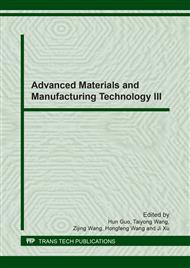[1]
Wang X. Research on improving performance of EDM processing fluid[D]. Yantai University, (2008).
Google Scholar
[2]
Shih H R, Shu K M. A study of electrical discharge grinding using a rotary disk electrode[J]. International Journal of Advanced Manufacturing Technology, 2008, 38(1): 59-67.
DOI: 10.1007/s00170-007-1068-y
Google Scholar
[3]
Wu Y, Zhang H, Ye P, et al. Edge fabrication and process optimization of precision woodworking PCD millers with disk electrical discharge machining[J]. International Journal of Advanced Manufacturing Technology, 2015: 1-8.
DOI: 10.1007/s00170-015-7945-x
Google Scholar
[4]
Guo Y, Zhang G, Wang L, et al. Experiment on electric discharge machining of cooling holes in superalloy IN718[J]. Journal of Aerospace Power, 2016, 31(2).
Google Scholar
[5]
Guo R, Li J, Guo L, et al. Optimization of the ultrasonic extraction technique of glycyrrhizic acid by using response surface methodology[J]. Journal of Northwest A & F University (Natural Science Edition), 2006, 34(9): 187-192.
Google Scholar
[6]
García-Cabeza A L, Ray L P, Marín-Barrios R, et al. Optimization by response surface methodology (RSM) of the Kharasch–Sosnovsky oxidation of valencene[J]. Organic Process Research & Development, (2014).
DOI: 10.1021/op5002462
Google Scholar
[7]
Barışçı S, Turkay O. Optimization and modelling using the response surface methodology (RSM) for ciprofloxacin removal by electrocoagulation. [J]. Water Science & Technology A Journal of the International Association on Water Pollution Research, 2015, 73(7).
DOI: 10.2166/wst.2015.649
Google Scholar
[8]
Wang L, Li W, Ma H, et al. Optimization of electrical parameters in WEDM machining[J]. Value Engineering, 2013(8): 35-36.
Google Scholar
[9]
Zhang L. Research of process and simulation of electrical discharge machining[D]. Xihua University, (2011).
Google Scholar
[10]
Hu Y. A comparative study on the second-order designs in response surface methodology[D]. Tianjin University, (2005).
Google Scholar


